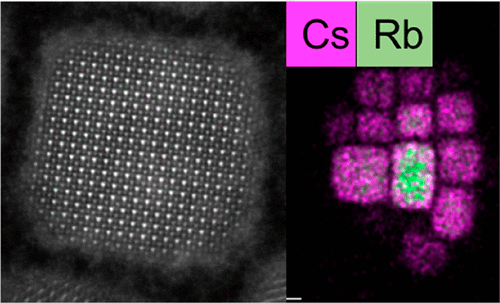当前位置:
X-MOL 学术
›
Chem. Mater.
›
论文详情
Our official English website, www.x-mol.net, welcomes your feedback! (Note: you will need to create a separate account there.)
Fully Inorganic Mixed Cation Lead Halide Perovskite Nanoparticles: A Study at the Atomic Level
Chemistry of Materials ( IF 8.6 ) Pub Date : 2020-01-10 , DOI: 10.1021/acs.chemmater.9b04426 Tal Binyamin 1 , Laurent Pedesseau 2 , Sergei Remennik 1 , Amal Sawahreh 1 , Jacky Even 2 , Lioz Etgar 1
Chemistry of Materials ( IF 8.6 ) Pub Date : 2020-01-10 , DOI: 10.1021/acs.chemmater.9b04426 Tal Binyamin 1 , Laurent Pedesseau 2 , Sergei Remennik 1 , Amal Sawahreh 1 , Jacky Even 2 , Lioz Etgar 1
Affiliation

|
Mixed cation perovskites are currently the most efficient perovskite materials used in perovskite solar cells. Mixing two cations inside a perovskite structure results in enhanced flexibility when designing interesting material properties. Moreover, using two inorganic cations in the same perovskite maintains the advantage of fully inorganic structures. A fascinating subject to investigate is therefore the nanoscale synthesis and the properties of such mixed inorganic cation perovskites. In this work we mixed Rb and Cs inorganic atoms inside perovskite nanoparticles. We explored down to the atomic resolution different Rb and Cs concentrations and performed the chemical mapping of single nanoparticles. At medium concentrations, the Rb atoms are observed in the core of the particles, whereas the Cs atoms are located in the shell region, forming core–shell structures. However, if there are high concentrations of Rb, a phase separation occurs because bulk perovskite based solely on Rb cations is not stable at room temperature. Density functional theory calculations support our experimental observations by showing that a stable nanoparticle is formed when the Rb atoms are located inside the particle and not on the surface. Our work demonstrates the importance of understanding the perovskite structure at the atomic level, leading to the formation of mixed cation bulk perovskites and nanoparticles and to improved perovskite stability. A new phase of cesium lead bromide (Cs6Pb5Br16) related to the Rb6Pb5Cl16 structure is also reported.
中文翻译:

完全无机混合阳离子卤化钙钛矿型纳米颗粒:在原子水平上的研究
混合阳离子钙钛矿是目前钙钛矿太阳能电池中使用的最有效的钙钛矿材料。在设计有趣的材料特性时,在钙钛矿结构内部混合两种阳离子可提高柔韧性。而且,在相同的钙钛矿中使用两种无机阳离子保持了完全无机结构的优势。因此,一个令人着迷的研究主题是这种混合的无机阳离子钙钛矿的纳米级合成及其性能。在这项工作中,我们在钙钛矿纳米粒子内部混合了Rb和Cs无机原子。我们探究了不同Rb和Cs浓度的原子分辨率,并对单个纳米粒子进行了化学作图。在中等浓度下,Rb原子位于颗粒的核心,而Cs原子位于壳区域,形成核-壳结构。但是,如果存在高浓度的Rb,则会发生相分离,因为仅基于Rb阳离子的块状钙钛矿在室温下不稳定。密度泛函理论计算表明,当Rb原子位于颗粒内部而不是表面时,会形成稳定的纳米颗粒,从而支持了我们的实验观察。我们的工作表明了在原子水平上理解钙钛矿结构的重要性,这导致混合阳离子块状钙钛矿和纳米颗粒的形成,并改善了钙钛矿的稳定性。溴化铯(Cs)的新阶段 密度泛函理论计算表明,当Rb原子位于颗粒内部而不是表面时,会形成稳定的纳米颗粒,从而支持了我们的实验观察。我们的工作表明了在原子水平上理解钙钛矿结构的重要性,这导致混合阳离子块状钙钛矿和纳米颗粒的形成,并改善了钙钛矿的稳定性。溴化铯(Cs)的新阶段 密度泛函理论计算表明,当Rb原子位于颗粒内部而不是表面时,会形成稳定的纳米颗粒,从而支持了我们的实验观察。我们的工作表明了在原子水平上理解钙钛矿结构的重要性,这导致混合阳离子块状钙钛矿和纳米颗粒的形成,并改善了钙钛矿的稳定性。溴化铯(Cs)的新阶段还报道了与Rb 6 Pb 5 Cl 16结构有关的6 Pb 5 Br 16)。
更新日期:2020-01-10
中文翻译:

完全无机混合阳离子卤化钙钛矿型纳米颗粒:在原子水平上的研究
混合阳离子钙钛矿是目前钙钛矿太阳能电池中使用的最有效的钙钛矿材料。在设计有趣的材料特性时,在钙钛矿结构内部混合两种阳离子可提高柔韧性。而且,在相同的钙钛矿中使用两种无机阳离子保持了完全无机结构的优势。因此,一个令人着迷的研究主题是这种混合的无机阳离子钙钛矿的纳米级合成及其性能。在这项工作中,我们在钙钛矿纳米粒子内部混合了Rb和Cs无机原子。我们探究了不同Rb和Cs浓度的原子分辨率,并对单个纳米粒子进行了化学作图。在中等浓度下,Rb原子位于颗粒的核心,而Cs原子位于壳区域,形成核-壳结构。但是,如果存在高浓度的Rb,则会发生相分离,因为仅基于Rb阳离子的块状钙钛矿在室温下不稳定。密度泛函理论计算表明,当Rb原子位于颗粒内部而不是表面时,会形成稳定的纳米颗粒,从而支持了我们的实验观察。我们的工作表明了在原子水平上理解钙钛矿结构的重要性,这导致混合阳离子块状钙钛矿和纳米颗粒的形成,并改善了钙钛矿的稳定性。溴化铯(Cs)的新阶段 密度泛函理论计算表明,当Rb原子位于颗粒内部而不是表面时,会形成稳定的纳米颗粒,从而支持了我们的实验观察。我们的工作表明了在原子水平上理解钙钛矿结构的重要性,这导致混合阳离子块状钙钛矿和纳米颗粒的形成,并改善了钙钛矿的稳定性。溴化铯(Cs)的新阶段 密度泛函理论计算表明,当Rb原子位于颗粒内部而不是表面时,会形成稳定的纳米颗粒,从而支持了我们的实验观察。我们的工作表明了在原子水平上理解钙钛矿结构的重要性,这导致混合阳离子块状钙钛矿和纳米颗粒的形成,并改善了钙钛矿的稳定性。溴化铯(Cs)的新阶段还报道了与Rb 6 Pb 5 Cl 16结构有关的6 Pb 5 Br 16)。



























 京公网安备 11010802027423号
京公网安备 11010802027423号